Creating a video membership site is a fantastic way to share your content and make money. With subscription plans, users can pay directly to access your videos. That way, you don’t have to depend on ads or other third-party sources of income. Plus, it opens up opportunities for steady revenue.
But creating a video membership site comes with its own set of challenges.
Many creators find it tricky when trying to manage everything from handling memberships to ensuring the right people have access to the content.
That said, with the right guidance and some handy tools, you can overcome these hurdles!
At WPBeginner, we use MemberPress to build our free video site, and it’s been working exceptionally well. In this guide, we’ll walk you through how to create a video membership site in WordPress.

What Do You Need to Start a Video Membership Website and Why Create One?
Making a video membership website these days is quite easy.
Using WordPress as your website platform gives you access to all the tools you’ll need to make a custom video membership website.
Here is what you’ll need to get started:
- A domain name. This will be your website’s address, such as
wpbeginner.com. - A website hosting account. This is where all your website files will be stored.
- A membership addon. This is to add subscription plans and restrict access to paid content.
- A video hosting platform. This is to securely deliver videos only to paid subscribers.
Now, before we dive into how to start a video membership website, it’s important to understand why it’s a great idea.
First off, a video membership site lets you connect with your audience in a more personal way.
So, instead of relying on ads that can interrupt your videos, you’ll have a space where your subscribers can enjoy your content without distractions. This helps build a loyal community that really cares about what you create.
Another big reason to create a membership site is the chance to earn a steady income. With subscription plans, you can earn recurring payments, which can help you invest in better equipment or new content ideas.
This kind of financial support makes it easier to keep your creative juices flowing and allows you to try new things. Plus, when you offer exclusive content, your subscribers will feel special and appreciated, making them more likely to stick around.
To learn more about offering exclusive content, you can read our guide on ways to protect content in WordPress.
In the end, a video membership website isn’t just about sharing videos; it’s about creating a space where your audience feels like they’re part of something.
Now, starting a fully functional video membership website can take less than 60 minutes, and we will walk you through every step.
Below are the steps that we will cover to help you make a powerful membership website with WordPress:
- Getting Started with a Video Membership Website
- Choosing a WordPress Video Membership Addon
- Setting Up Your WordPress Video Membership Website
- Adding Payment Methods
- Creating Subscription Plans for Video Membership Site
- Creating Access Rules for Video Membership Plans
- Adding Members-Only Content in MemberPress
- Uploading Members-Only Videos in MemberPress
- Building a Pricing Page for Your Membership Plans
- Embedding Login and Sign-Up Forms for Your Video Membership Site
- Customizing Email Templates for Your Membership Site
- Growing Your Video Membership Website
Ready? Let’s get started in creating your own video membership site!
Step 1. Getting Started with a Video Membership Website
The easiest way to build a video membership website is to use WordPress. It’s the best website builder on the market and allows you to create any kind of website imaginable.
Before you get started, you’ll need to make sure you are using the right type of WordPress. There are two kinds of WordPress on the market.
First, there is WordPress.com, which is a website hosting service. Then, there is WordPress.org, also known as self-hosted WordPress. For details, see our comparison of WordPress.com vs WordPress.org.
We’ll be using self-hosted WordPress.org as it gives you complete freedom and instant access to all WordPress features that are out of the box.
Now, you’ll need a domain name and a hosting account for a self-hosted WordPress website.
A domain name typically costs about $14.99 annually, and web hosting plans start from $7.99 monthly.
If you are just starting out, then you would want to cut costs whenever possible without compromising your business.
Luckily, Bluehost has agreed to offer WPBeginner users a generous discount on hosting with a free domain. Basically, you can get started for $1.99 per month.
Bluehost is one of the largest hosting companies on the market, and they’re an officially recommended WordPress hosting provider.
Once you have signed up for your hosting account, Bluehost will automatically install WordPress for you.
You can simply log in to your WordPress dashboard directly from your hosting account by clicking on the ‘Edit Site’ button.
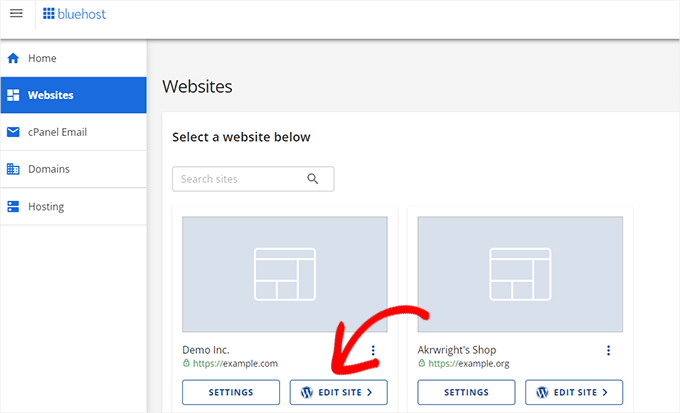
If you need more help, you can see our WordPress installation tutorial or follow our step-by-step guide on how to start a blog.
Step 2. Choosing a WordPress Video Membership Addon
There are several WordPress membership add-ons that allow you to create a membership website. However, each one of them has their own pros and cons.
For more details, see our full comparison of the best WordPress membership plugins.
Before you choose a membership addon, you need to decide what kind of video membership site you want to make.
For instance, if you just want users to register and be able to download a few small videos, then you can do that with WPForms. It comes with support for popular payment gateways like PayPal and Stripe.
Plus, you can redirect users to download a file or to any URL once they have submitted a form.
However, if you want proper access control, subscription plans, multi-level subscriptions, and more, then you’ll need a complete WordPress video membership addon like MemberPress.
🚨 We actually use MemberPress to build our free video site. It has everything we need to make sure everything runs smoothly, and you can find out everything about it in our detailed MemberPress review.
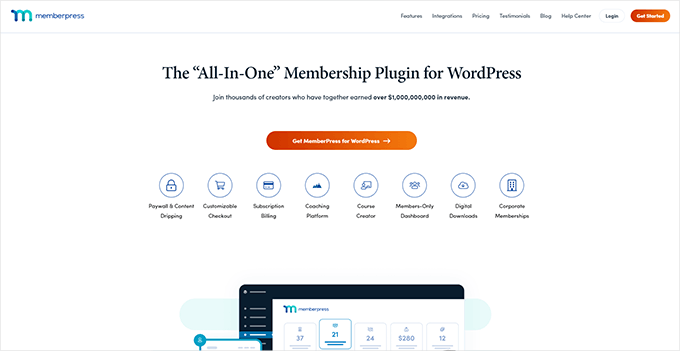
MemberPress is the best WordPress membership and content protection plugin on the market. It allows you to accept payments, create membership levels, restrict access to video pages based on levels, and more.
You can also use it to sell courses online. Plus, if you choose to host your videos on AWS (more on this later), then MemberPress comes with an extension to host your video files on the cloud.
It has all the features you’ll need to run a video membership website and integrates with all the tools that you may want to use to grow your business.
Alternative: If you’re looking for a MemberPress alternative, we also recommend Thrive Apprentice or AccessAlly. It is one of the best LMS plugins for selling online courses, and it comes with membership features to protect your content from non-members.
Step 3. Setting Up Your WordPress Video Membership Website
We’ll be using MemberPress to set up a video membership website in WordPress.
First, you need to install and activate the MemberPress plugin. For more details, see our step-by-step guide on how to install a WordPress plugin.
Upon activation, you need to visit the MemberPress » Settings page to configure the plugin settings.
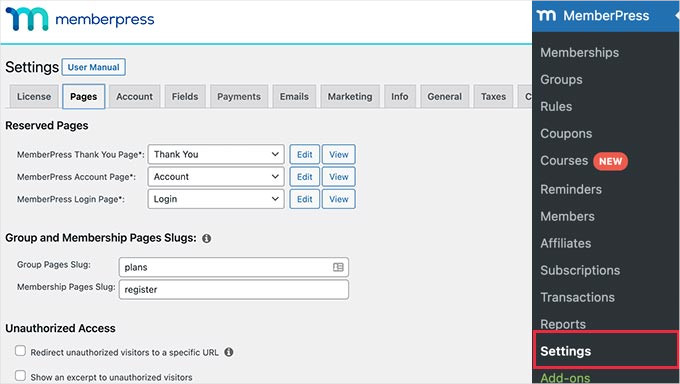
We will walk you through the most important settings to configure in the next few steps.
Step 4. Adding Payment Methods
The settings page is divided into different tabs. The first thing you need to set up is a payment gateway, which allows you to accept payments on your membership site.
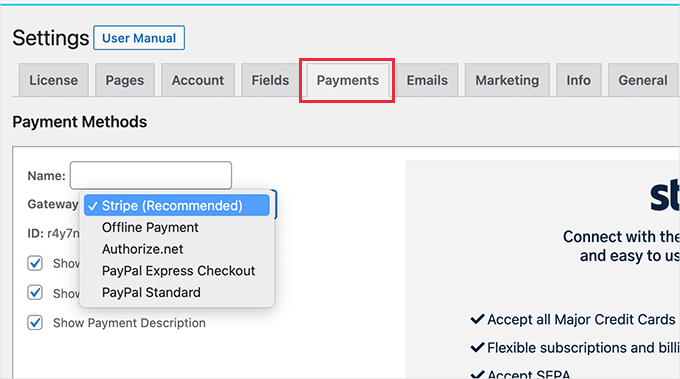
MemberPress supports PayPal (Standard, Express, and Pro), Stripe, and Authorize.net out of the box. To set up a payment method, you simply need to select it and provide the required credentials.
Optionally, you can also choose to add multiple payment methods. For instance, you can add Stripe and then add PayPal for users who prefer not to share their credit card details.
After adding payment methods, don’t forget to click on the ‘Update Options’ button to save your settings before moving on to the next step.
Step 5. Creating Subscription Plans for Video Membership Site
Next, you need to create different subscription levels to which users can subscribe.
For instance, you can create plans with different perks, access levels, and features. You can even create a free membership plan where users can watch demo videos and access free content.
To create a new membership plan, simply go to the MemberPress » Memberships page and click on the ‘Add New’ button at the top.
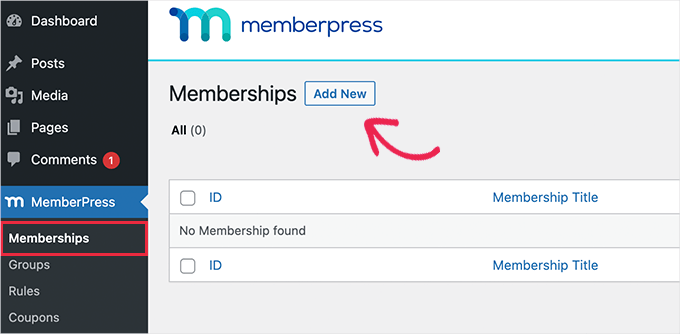
On the next screen, you’ll need to provide a title for the membership plan and then add details in the post editor.
Next, you need to set this plan’s pricing, billing type, interval, and expiration under the ‘Membership Terms’ section in the right column.
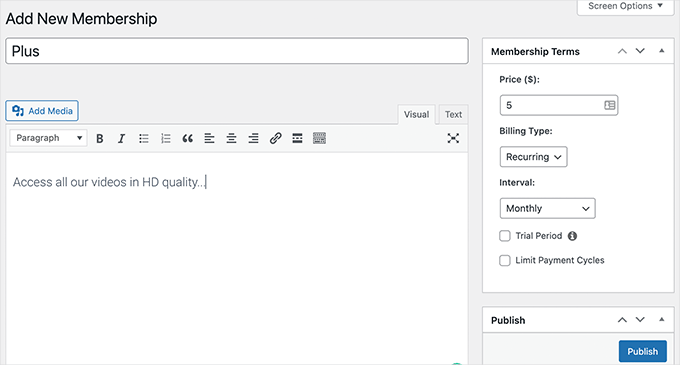
For instance, in the above screenshot, we created a video membership plan with recurring monthly payments.
Now, you need to scroll down to the ‘Membership Options’ box below the editor. From here, you can customize plan permissions and membership options.
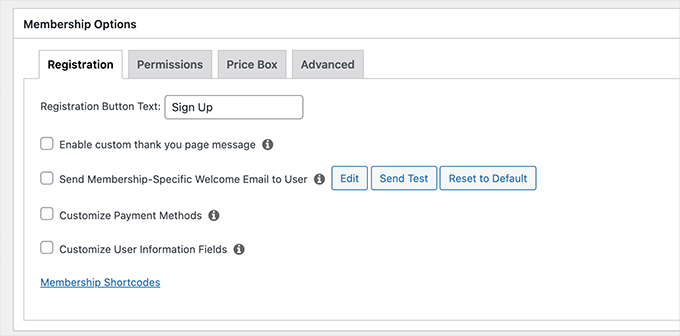
After you are satisfied with the plan, you can go ahead and publish it.
If you want to create more membership levels, then simply repeat the process to create other membership plans as needed.
Step 6. Creating Access Rules for Video Membership Plans
Now that you have set up membership levels, the next step is to set up access rules.
MemberPress comes with powerful access control rules, which allow you to restrict access to any content on your website based on a user’s membership plan.
To set up rules, simply head over to the MemberPress » Rules page and click on the ‘Add New’ button to create a new rule.
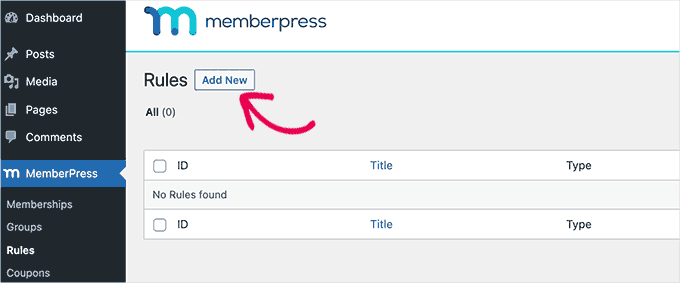
The rule edit page allows you to select and associate different conditions to any membership plan.
For instance, you can select all content that matches a particular tag or category to be available only to members with the ‘Plus’ plan.
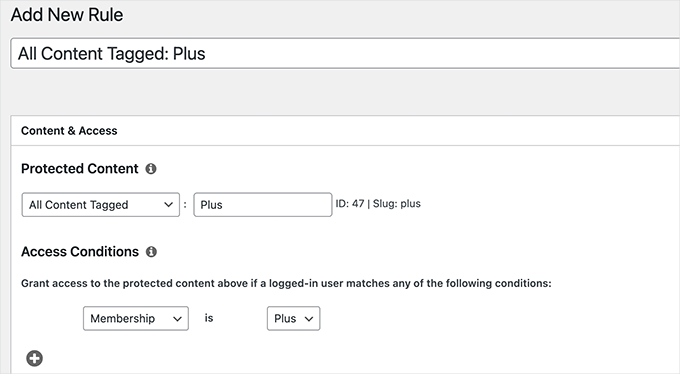
You can also target specific posts and pages, a specific URL, and more.
Setting Up Drip Content Rules
MemberPress also comes with a drip content feature. This allows you to automatically give users access to your videos on a schedule instead of giving them access to all premium content as soon as they sign up.
The drip content feature allows you to keep users engaged for longer, which provides you opportunities to upsell more products or simply offer users a better experience.
For instance, you can create a separate rule for posts with a specific tag to be available one week after a user registers.

Once you are satisfied with the ‘Rules’ settings, you can go ahead and click on the ‘Save Rule’ button to apply it.
Feel free to create more rules for your video membership plans as needed.
Step 7. Adding Members-Only Content in MemberPress
MemberPress makes it very easy to add members-only content to your website.
First, you’ll need to create a post or page to add your video and restrict access to that page as needed.
After that, we will show you how to embed members-only videos with privacy and security so they are not easily stolen from your website.
To get started, simply create a new post or page in WordPress and then add the tag or category you previously added as a rule in Step 6.
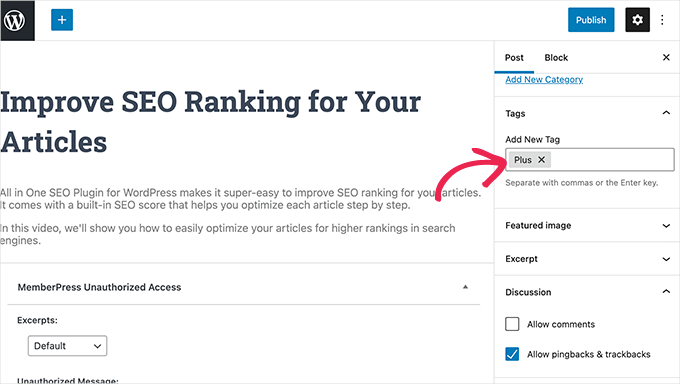
When it’s ready, you can simply go ahead and publish your restricted post or page.
Step 8. Uploading Members-Only Videos in MemberPress
One of the major challenges that video subscription websites face is how to offer the best viewing experience with full control over who has access to paid videos.
We strongly recommend that you do not just upload videos to your WordPress media library and add them to your posts and pages.
First, it’s not secure or private.
Secondly, video files take a lot of bandwidth, storage, and server resources, which will slow down or even crash your website.
For more on this topic, see our article on why you should never upload videos in WordPress.
We recommend 2 possible solutions that will work reliably for your video membership website: Vimeo or AWS.
Method 1. Embedding Members-Only Videos via Vimeo
The first one is Vimeo. Their paid plans give you greater privacy controls and allow you to embed videos easily on your membership website.
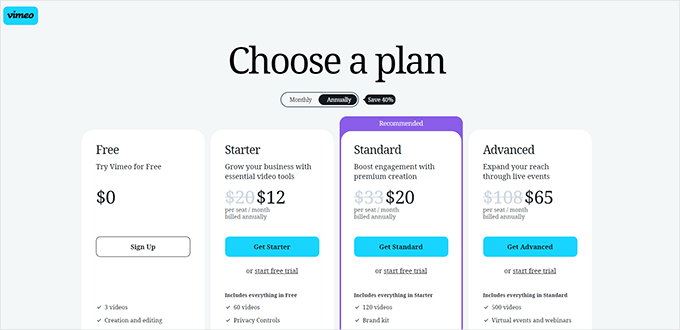
With Vimeo Plus, you can:
- Make your videos private
- Make videos unavailable on Vimeo itself. You can still upload and manage videos from your Vimeo dashboard, but others cannot view them on Vimeo.
- Set domain-level restrictions so your members-only videos can only be embedded and played on your own website.
- Password-protect your videos and more!
Apart from privacy and security features, Vimeo offers your users a much better streaming experience.
Embedding Vimeo videos on your members-only website is super easy. You only need to copy and paste the video URL into your content, and WordPress will automatically fetch and embed it.
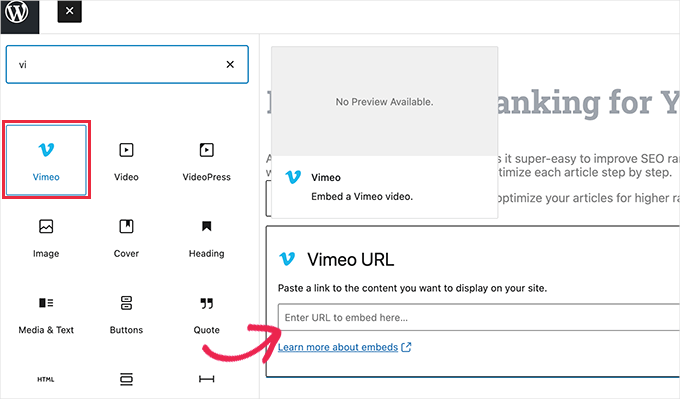
Alternative: Are you considering YouTube? Check out our head-to-head comparison of YouTube vs. Vimeo for insights!
Method 2. Upload Members-Only Videos via AWS
For this method, you’ll host your videos on Amazon’s AWS platform. This allows you to only programmatically give MemberPress access to your video files stored on Amazon cloud servers.
Do note that Amazon Web Services is a pay-as-you-go service. They have a limited free tier, and after that, you’ll be charged for bandwidth and storage used by your videos.
To start, you need to visit the Amazon Web Services (AWS) website and sign up for an account.
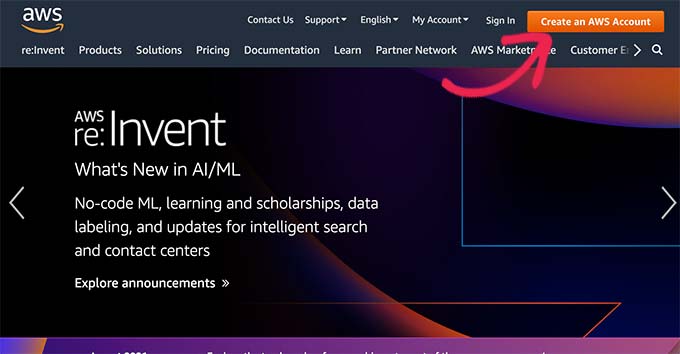
AWS comes with a bunch of cloud services that you can use. For a video membership website, we’ll use Amazon S3 cloud storage to host our video files.
Simply click on the ‘Services’ menu at the top and then look for S3.
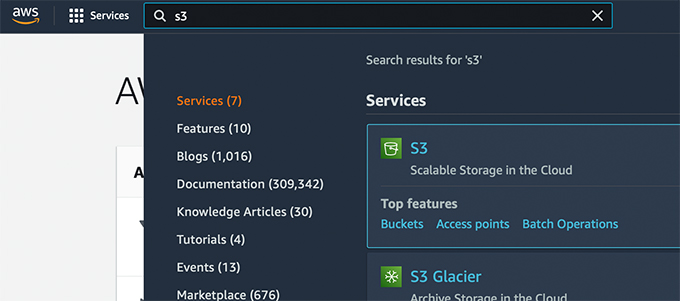
This will bring you to the S3 cloud storage dashboard. S3 cloud storage is organized in buckets. You can create multiple buckets for each of your websites or projects.
So, let’s create a bucket to store your members-only video files.
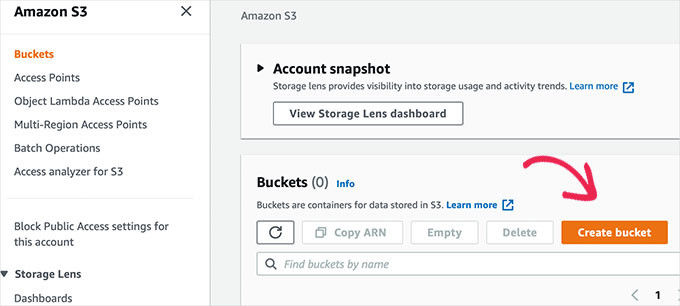
On the next screen, you need to provide a name for your bucket and choose a region.
Make sure that your bucket name is in lowercase only and that you use a region close to most of your users.
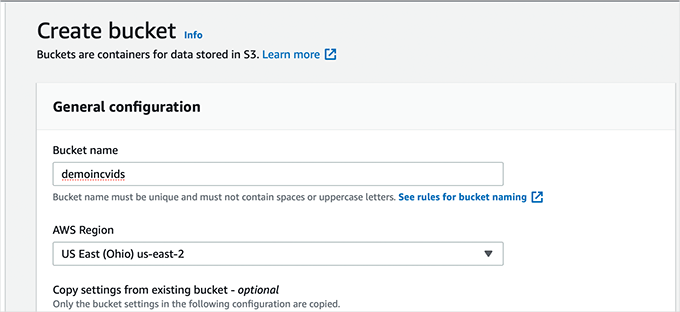
You can leave the rest of the settings as they are and click on the ‘Create Bucket’ button to continue.
AWS will now create a bucket where you can upload files. Simply click on your bucket name to open it and click on the ‘Upload’ button to add your first video.
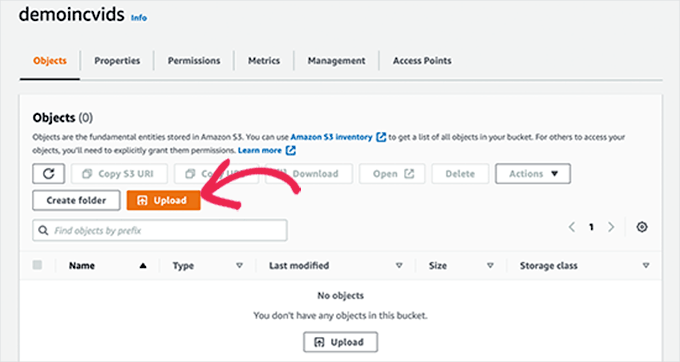
Repeat the process if you need to upload more files right now or later in the future.
Once video files are uploaded to AWS, they are not publicly visible. To do that, you will need to generate security credentials first.
Simply click on your ‘Account’ title at the top right corner of the screen and then select ‘Security Credentials.’
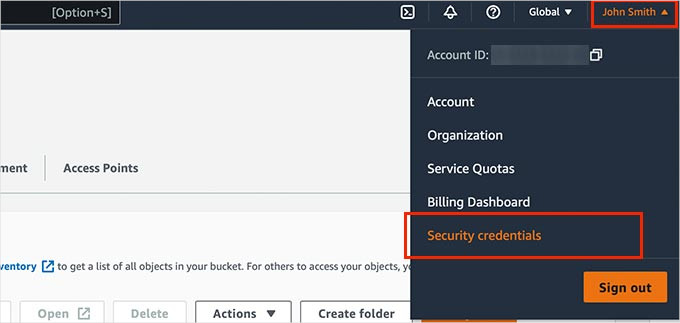
On the next screen, you can click on the ‘Access Keys tab to expand it.
From here, you’ll need to click on the ‘Create New Access Key’ button to generate new keys.
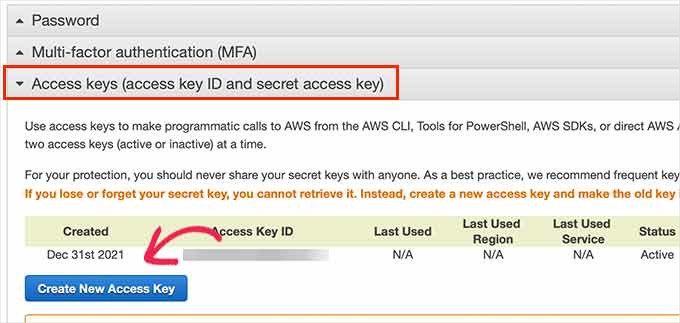
This will bring up a popup where you’ll click the ‘Show Access Keys’ link.
Then, you’ll want to copy your ‘Access Key ID’ and ‘Secret Access Key’ to a text file, as you’ll need them later.
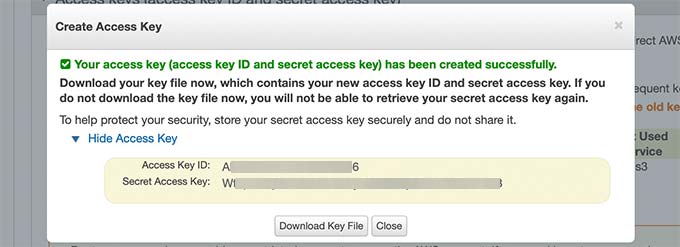
Next, let’s switch to the admin area of your WordPress website and go to the MemberPress » Add-ons page.
From here, you need to scroll down to Amazon Web Services (AWS) and click on the ‘Install Add-on’ button.
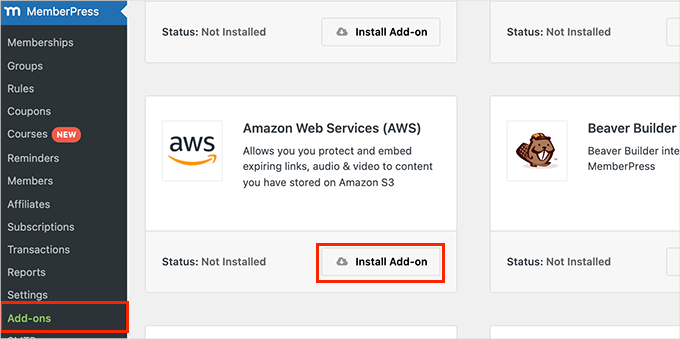
After that, you need to connect MemberPress to your AWS account.
Simply go to the MemberPress » Settings page and switch to the ‘AWS’ tab.
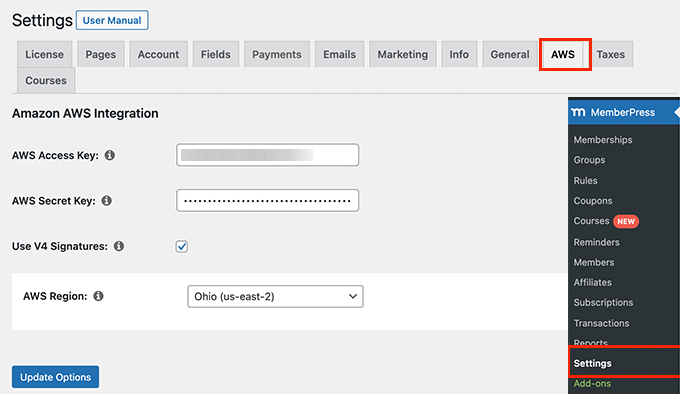
Here, you can paste the ‘Access Key ID’ and ‘Secret Access Key’ you copied earlier.
Below that, you’ll want to check the box next to the V4 Signature option and then select your AWS region. This is the same region that you choose when setting up your ‘S3 Bucket.’
Don’t forget to click on the ‘Update Options’ button to save your settings.
Adding AWS Hosted Videos to Your WordPress Site
Now that you have connected MemberPress to your AWS account, you can go ahead and add your videos to your members-only posts and pages.
You will need to embed the video using a shortcode like this:
[mepr-s3-video src="demoincvids/video-tutorial-001.mp4"]
You’ll simply need to replace the part in quotes, which is the video’s location.
You can find your video’s location in the S3 dashboard for your Amazon AWS account. Simply click on your bucket and then the file name to see the file location.
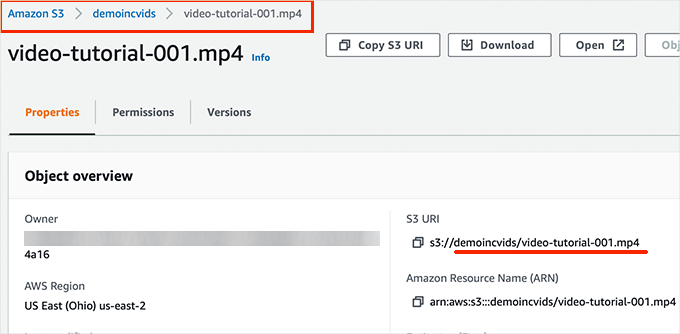
After adding the shortcode, you can save your post or page.
Then, preview it to see your embedded video in action.

From here, you can repeat the process to add more members-only videos to your website.
Step 9. Building a Pricing Page for Your Membership Plans
If you have multiple plans, then you may want to create a pricing page where users can compare and choose a plan.
Users who try to access your website’s restricted or paid areas will also be redirected to your pricing page.
You can configure this by going to the MemberPress » Groups page and clicking on the ‘Add New’ button at the top.
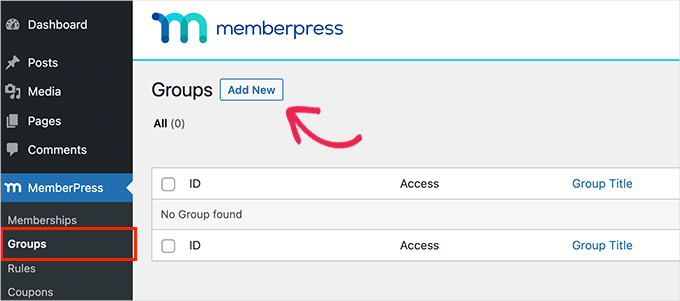
On the next screen, you need to provide a title for your pricing page. It will also be used in your group pricing page URL.
Below that, you’ll choose which plans you want to include.
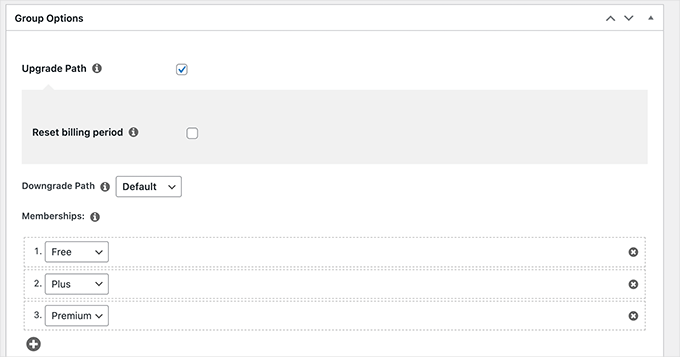
You can also select a theme for the pricing table. Thankfully, MemberPress comes with a few ready-made templates for that.
Once everything looks good, go ahead and hit the ‘Publish’ button to make your plan publicly visible.
To preview your pricing page, simply click on ‘View Group’ after publishing it.
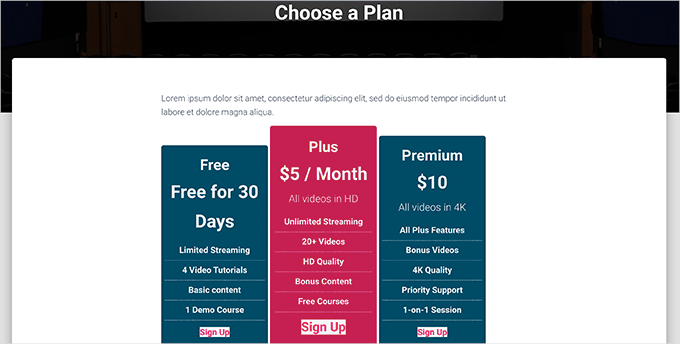
Redirecting Users to Your Membership Plans Page
Now that you have created a pricing page, you would want to automatically redirect users to compare plans and make a purchase.
To do that, first, you need to head over to MemberPress » Groups and copy the URL next to the group you created earlier.
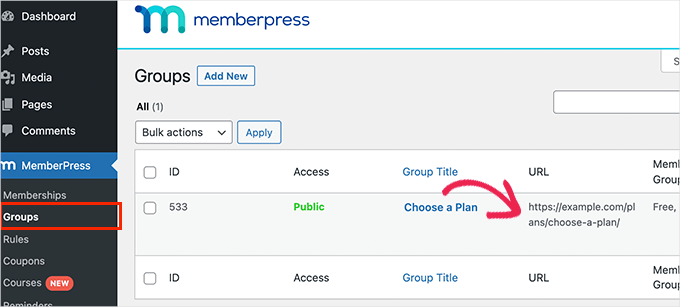
After that, let’s go to MemberPress » Settings and switch to the ‘Pages’ tab.
From here, you’ll want to scroll down to the ‘Unauthorized Access’ section.
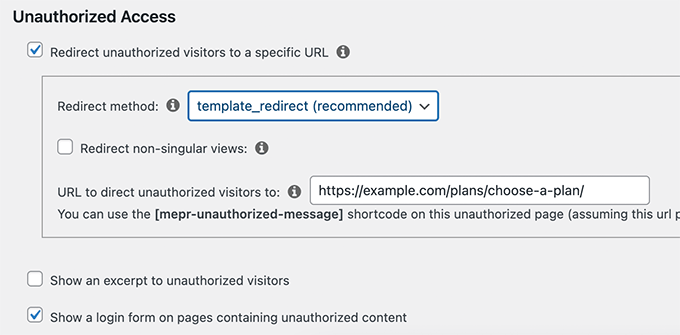
Then, let’s check the box next to the ‘Redirect unauthorized visitors to a specific URL’ option and then paste the group URL you copied earlier.
Don’t forget to click on the ‘Update Options’ button to save your settings.
Now, unauthorized users will be redirected to the pricing plans page when accessing your members-only content or videos.
Step 10. Embedding Login and Sign-Up Forms for Your Video Membership Site
Now that everything is set up, let’s make it easy for users to log in to their accounts or sign up.
MemberPress makes it very easy to add login forms to your website.
Simply navigate to the Appearance » Widgets page and add the ‘MemberPress login’ widget to a sidebar.
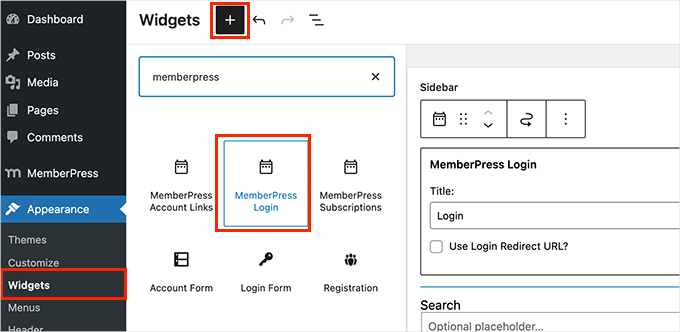
Don’t forget to click on the ‘Update’ button to save your widget settings.
The next step is to add a link to the pricing page to your website’s navigation menu.
To do this, you can go to Appearance » Menus and click on the ‘Groups’ tab to expand it. Then, you’ll want to select the pricing plan group you created earlier and then click on the ‘Add to Menu’ button.
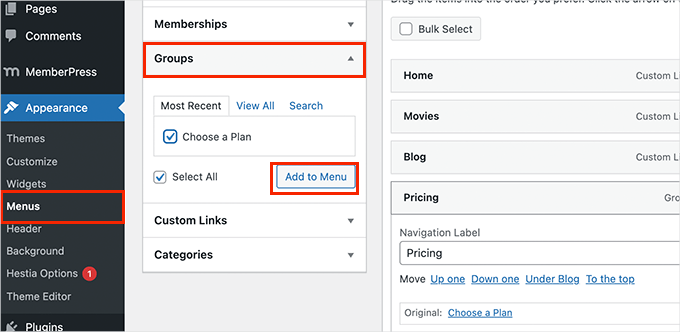
Don’t forget to click on the ‘Save’ button to store your changes.
You can now log out of the admin area and visit your website to see everything in action.
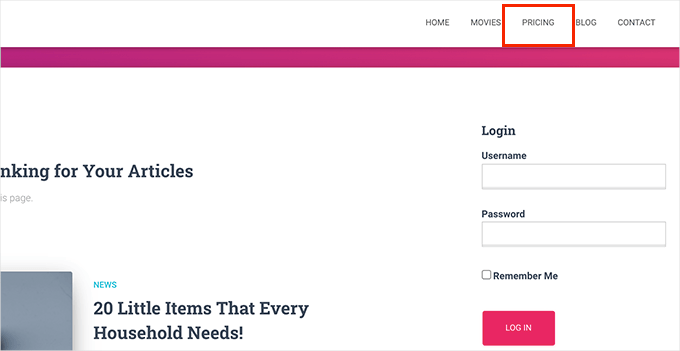
Related: If you want to prevent users from password sharing, see our guide on how to restrict user login to one device in WordPress.
Step 11. Customizing Email Templates for Your Membership Site
Your video membership website will send users emails when they sign up or forget a password, when their membership is about to expire, and so on.
You can customize these email templates in MemberPress.
Simply go to MemberPress » Settings and switch to the ‘Emails’ tab. From here, you’ll see the list of emails your video membership site will send, and you can edit any of them.
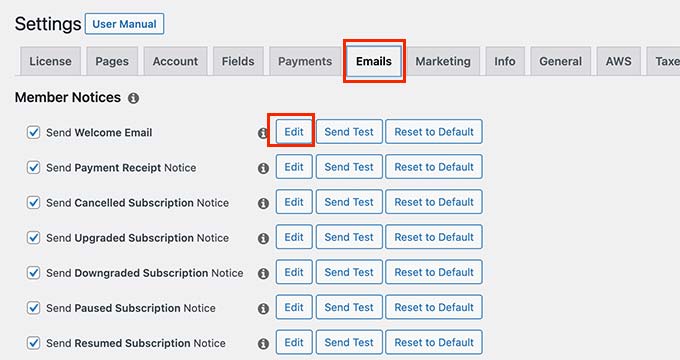
This will open the email template in a plain text editor.
You can use the smart tags below to personalize messages and match them to your own brand’s tone and messaging.
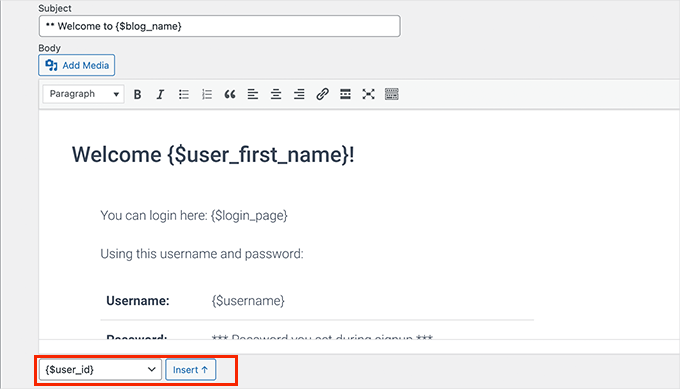
Important: Don’t forget to send test emails to make sure they are working. For more help, see our guide on how to fix WordPress not sending email issue.
Step 12. Growing Your Video Membership Website
Now that your video membership site is ready, let’s talk about how to get more users to visit your website and sign up.
Luckily, using MemberPress and WordPress gives you access to incredibly powerful tools to grow your business. Here are some must-haves:
- OptinMonster – It is the best lead generation and conversion optimization tool on the market and allows you to easily convert website visitors into paid subscribers.
- All in One SEO – It is the best WordPress SEO plugin that allows you to optimize your videos and entire website for search engines without any technical skills.
- SeedProd – The best WordPress page builder plugin to easily create beautiful custom landing pages for your video membership website.
- WPForms – It is the best WordPress form builder on the market and allows you to create contact forms, login and signup forms, user registration forms, and more.
- MonsterInsights – Allows you to easily track your website performance using Google Analytics. It shows beginner-friendly reports to see your top content and track conversions to boost sales.
Need more recommendations? See our list of the must-have WordPress plugins for all websites.
We hope this article helped you build a video membership website in WordPress. You may also want to see our guides on how to restrict user login to one device and how to sell group memberships for corporate teams.
If you liked this article, then please subscribe to our YouTube Channel for WordPress video tutorials. You can also find us on Twitter and Facebook.





maj
Can I setup a subscription plan for video downloads?
For example, I have Tier A, B, C.
Those who subscribe to Tier A – can download videos across the membership 5 times
Those who subscribe to Tier B – can download videos across the membership 15 times
Those who subscribe to Tier C – can download videos across the membership 25 times..
All download limits will reset monthly.
And once their download limit is all used up, they will not be able to download any videos until their limit is reseted the next month.
WPBeginner Support
Unless we hear otherwise that is not currently an option but possibly in the future!
Admin
R J
Hi- How can I set up a youtube like website on wordpress?
WPBeginner Support
Before you look to create a site like that, we would first recommend taking a look at our recommendations regarding uploading videos to your site below.
https://www.wpbeginner.com/beginners-guide/why-you-should-never-upload-a-video-to-wordpress/
Admin
Kevin Rabbit
Great article. I’d like to offer members a forum and chat service. Would I be able to do this? That would allow them to discuss topics and also message each other without relying too much on the Admin to reply to everything.
I would also be interested to know what you use for this form. I’d like people to be able to subscribe to comments just as you are doing here
Thanks
Kevin
WPBeginner Support
You can use a forum plugin to add a forum to your site, we have an article that covers how to set up bbPress for a forum in our article below:
https://www.wpbeginner.com/wp-tutorials/how-to-add-a-forum-in-wordpress-with-bbpress/
We use the default WordPress comments and not a form for our site
Admin
Achim Gehrig
Nice walkthrough!
Any recommendations to use an existing video library on YouTube instead of Vimeo or AWS?
WPBeginner Support
At the moment we do not have a recommended method for using YouTube with YouTube’s current privacy options.
Admin